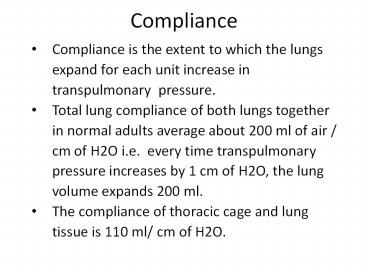Compliance - PowerPoint PPT Presentation
Title:
Compliance
Description:
Compliance Compliance is the extent to which the lungs expand for each unit increase in transpulmonary pressure. Total lung compliance of both lungs together – PowerPoint PPT presentation
Number of Views:158
Avg rating:3.0/5.0
Title: Compliance
1
Compliance
- Compliance is the extent to which the lungs
- expand for each unit increase in
- transpulmonary pressure.
- Total lung compliance of both lungs together
- in normal adults average about 200 ml of
air / - cm of H2O i.e. every time transpulmonary
- pressure increases by 1 cm of H2O, the lung
- volume expands 200 ml.
- The compliance of thoracic cage and lung
- tissue is 110 ml/ cm of H2O.
2
- Compliance depends on two factors
- Elastic Fibers
- Surface tension in alveoli
- Elastance is the property of lung to come back to
its original volume when stretching force is
removed.
3
Surface Tension in Alveoli
- The law of LaPlace states that the pressure
within a fluid-lined alveolus depends on two
factors the surface tension of the fluid and the
radius of the alveolus. This relationship is
expressed by the equation - P 2 . T/ r
4
Surfactant
- It is a mixture containing lipoprotein such as
dipalmitoylphosphatidylcholine, apoproteins and
calcium ions - Secreted by type II alveolar cells.
- Secretion starts at 25th week of gestation, peak
at 32nd week. - Hyaline membrane disease
5
Role of surfactant for preventing alveolar
collapse
6
Airway resistance
- Poiseuilles Law
- R is directly proportional to L?/r
4
7
Factors affecting Airway resistance
- Length --- constant ,not a factor
- Viscosity of air--- Usually constant.Humidity and
altitude may alter slightly - Diameter of upper airways is affected by physical
obstruction e.g.mucus and other factors - Diameter of bronchioles
- Bronchoconstriction---Parasympathetics,
- , histamine.
- Bronchodilation---CO2, epinephrine.
8
Factors affecting Airway Resistance
9
Obstructive Airway Diseases
- Chronic Bronchitis
- Asthma
- Emphysema
10
Fibrotic lung diseases
- Often results from the chronic inhalation of fine
particulate matter that escapes the mucus lining
of the airways and reaches the exchange
epithelium of the alveoli ,eventually resulting
in formation of inelastic scar tissue. - The proliferation of inelastic scar tissue in the
lung is called fibrotic lung disease or fibrosis. - Inorganic particles that can trigger fibrosis are
asbestos,coal dust,silicon,and even dust and
pollutants of urban areas.
11
Pulmonary Ventilation
- Pulmonary ventilation is defined as inflow
outflow of air between the atmosphere the lung
alveoli - Inflow ? Inspiration
- Outflow ? Expiration
12
The recording spirometer
13
Spirogram
14
Lung volumes
- Tidal volume is the volume of air that moves in a
single normal inspiration or expiration. - Inspiratory reserve volume is the additional
volume inspired above the tidal volume - Expiratory reserved volume is the amount of air
exhaled after the end of a normal expiration - Residual volume is the volume of air in the
respiratory system after maximum exhalation
15
Lung capacities
- Inspiratory capacity is the amount of air a
person can breathe in, beginning at the normal
expiratory level and distending the lungs to the
maximum amount. - Functional residual capacity is the amount of
air that remains in the lung at end of normal
passive expiration - Vital capacity is the maximum amount of air that
can be voluntarily moved in to or out of the
respiratory system with one breath. - Total lung capacity is the volume to which lungs
can be expanded with the greatest possible
effort.
16
(No Transcript)
17
(No Transcript)
18
FRC determination

